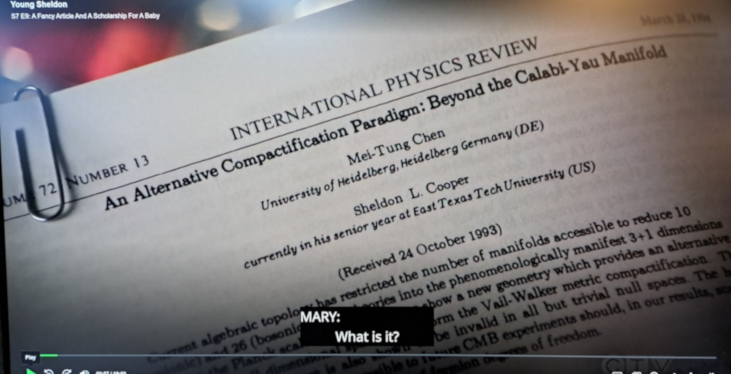One of the reasons why I find the sitcom, The Big Bang Theory, as well as its spinoff, Young Sheldon, enjoyable, is the fact that they respect the science.
That is to say, the science that we see pop up in the series from time to time is, well, it may be fictitious but not bogus. Not gobbledygook.
Here’s the latest example. In the most recent Young Sheldon episode, we see Sheldon’s first paper, published in the fictitious journal, “International Physics Review”.

The journal may be fictitious, but the format is not: It’s the standard Physical Review layout, pretty much. Looks quite legit!
The title actually makes sense. The Calabi-Yau manifold is a popular mathematical tool, used to deal with, or “compactify” the unwanted excess dimensions of 10-dimensional supersymmetric string theory.
The abstract cannot be read in full, but the words that are visible are not nonsense. OK, as far as I know there is no “Vail-Walker metric compactification”, but the fragments of text that we can read actually make sense, sort of: which is to say, the words are not randomly strung together, they actually form expressions that you might encounter in entirely legitimate physics texts.
I mean, usual Hollywood would have something like this Midjourney creation on a sheet of paper or a blackboard:

Midjourney’s response to the prompt, “A gentlecat physicist in front of a blackboard discussing the Schwarzschild metric”.
I mean, Midjourney draws lovely physicist cats, but it certainly knows nothing about the Schwarzschild solution. The creators of The Big Bang Theory do: If Sheldon Cooper talks about the Schwarzschild solution, you can bet that in the background, on the blackboard you’d see something like \(ds^2=(1-2GM/r)dt^2-(1-2GM/r)^{-1}dr^2-r^2d\theta^2-r^2\sin^2\theta d\phi^2.\)